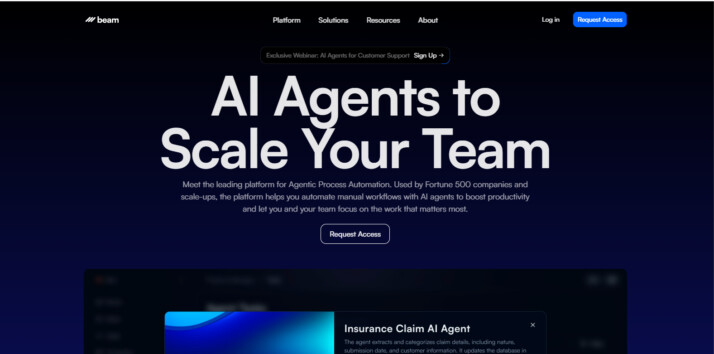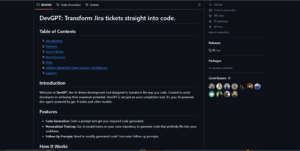Beam AI vs. DevGPT: Comparing AI Automation Tools
AI-powered automation tools reshape software development and business processes, offering unprecedented efficiency and innovation. Beam AI vs. DevGPT exemplify this transformation, each bringing unique strengths to the table. Beam AI excels in creating autonomous agents for wide-ranging business automation, while DevGPT focuses on transforming natural language into code. This comparison delves into their features, capabilities, and limitations, revealing how SmythOS emerges as a superior alternative. By combining the strengths of both platforms and addressing their shortcomings, SmythOS offers a comprehensive solution for businesses seeking to harness AI’s full potential. From robust security measures to versatile deployment options and an extensive integration ecosystem, SmythOS stands out as the ideal choice for organizations aiming to revolutionize their workflows and drive innovation.
Beam AI Overview
Beam AI specializes in creating intelligent, autonomous agents designed to streamline business processes and boost productivity. These Agentic Process Automations (APAs) tackle repetitive tasks across various domains, including data management, customer service, compliance, and order processing. By continuously learning and adapting, Beam AI’s agents enhance their efficiency over time, allowing organizations to focus on higher-value work.
Beam AI specializes in creating intelligent, autonomous agents designed to streamline business processes and boost productivity.
Beam AI emphasizes sustainability and speed in its AI-native approach. The platform’s agents integrate seamlessly with existing systems, enabling comprehensive workflow automation. With advanced conversational interfaces, these agents facilitate smooth interactions between humans and AI, improving task execution and management.


Beam AI’s platform offers robust features for deploying and managing AI agents in both development and production environments. It supports multi-agent collaboration, allowing teams of AI agents to work together on complex tasks. The system also provides audit logs and monitoring capabilities, ensuring transparency and accountability in agent activities.
Beam AI’s platform offers robust features for deploying and managing AI agents in both development and production environments.
While Beam AI delivers powerful automation solutions, it lacks certain features found in other platforms. The absence of a visual builder or no-code editor may limit accessibility for non-technical users. Additionally, the platform doesn’t offer multimodal capabilities or support for data lakes, potentially constraining its application in certain scenarios.
Despite these limitations, Beam AI’s focus on creating adaptive, intelligent agents positions it as a strong contender in the AI automation space. Its emphasis on scalability, security, and integration capabilities makes it particularly suitable for enterprises looking to implement advanced AI solutions across their operations.
DevGPT Overview
DevGPT transforms natural language prompts into executable code, streamlining software development workflows. This open-source AI assistant empowers developers to describe coding needs in plain English, generating context-relevant code snippets automatically.


DevGPT integrates with services like GitHub and Jira, facilitating seamless pull request generation from tasks and tickets. Leveraging advanced models such as GPT-4 and Codex, the platform offers personalized training on a developer’s codebase to produce code matching their style. Users can provide feedback on generated code through comments, further tailoring the output to their needs.
DevGPT integrates with services like GitHub and Jira, facilitating seamless pull request generation from tasks and tickets.
The tool’s productivity-enhancing capabilities save developers significant time on repetitive coding tasks. Initial users report over 10 hours saved per week, allowing them to focus on complex coding challenges. While DevGPT currently caters primarily to individuals and small teams, its vision includes expanding accessibility to companies of all sizes.
However, DevGPT’s focus on code generation may limit its applicability for non-coding tasks or broader AI agent development. The platform’s reliance on external AI models could potentially impact performance or cost-effectiveness for large-scale deployments. Additionally, the current emphasis on individual developers and small teams might mean limited enterprise-level features or support for complex, multi-agent systems.
Feature Comparison
Beam AI and DevGPT offer distinct approaches to AI-powered software development, each with its own strengths and limitations. Beam AI focuses on creating autonomous AI agents for task automation across various business processes. DevGPT specializes in converting natural language prompts into executable code.
Beam AI provides robust support for deploying autonomous agents in both development and production environments. Its platform enables multi-agent collaboration and human-AI interaction, with features like audit logs and work scheduling. However, Beam AI lacks a visual builder or no-code editor, potentially limiting accessibility for non-technical users.
DevGPT, while powerful for code generation, has a narrower focus compared to Beam AI’s broader automation capabilities. It excels at transforming natural language descriptions into code snippets and integrates well with development tools like GitHub and Jira. But DevGPT doesn’t offer the same level of autonomous agent functionality or multi-agent systems that Beam AI provides.
In terms of security, both platforms emphasize data protection, but SmythOS offers more comprehensive features. Unlike Beam AI and DevGPT, SmythOS provides IP control, OAuth integration, and a wider range of deployment options, including as APIs, webhooks, and scheduled agents. SmythOS also stands out with its visual builder, no-code editor, and support for data lakes — capabilities absent in both Beam AI and DevGPT.
Feature Comparison Table
| Beam AI | DevGPT | SmythOS | |
|---|---|---|---|
| CORE FEATURES | |||
| Hosted Agents (Dev, Production) | ✅ | ❌ | ✅ |
| Environments (Dev, Production) | ✅ | ❌ | ✅ |
| Visual Builder | ❌ | ❌ | ✅ |
| No-Code Options | ❌ | ❌ | ✅ |
| Autonomous Agents | ✅ | ❌ | ✅ |
| Explainability & Transparency | ✅ | ❌ | ✅ |
| Debug Tools | ❌ | ✅ | ✅ |
| Multimodal | ❌ | ❌ | ✅ |
| Multi-Agent Collaboration | ✅ | ❌ | ✅ |
| Audit Logs for Analytics | ✅ | ❌ | ✅ |
| Bulk Work | ✅ | ❌ | ✅ |
| Agent Work Scheduler | ✅ | ❌ | ✅ |
| Logs & Monitoring | ✅ | ❌ | ✅ |
| SECURITY | |||
| Constrained Alignment | ✅ | ❌ | ✅ |
| Data Encryption | ✅ | ❌ | ✅ |
| OAuth | ✅ | ❌ | ✅ |
| IP Control | ✅ | ❌ | ✅ |
| COMPONENTS | |||
| Foundation AIs | ✅ | ❌ | ✅ |
| Huggingface AIs | ✅ | ❌ | ✅ |
| Zapier APIs | ✅ | ❌ | ✅ |
| All other APIs, RPA | ✅ | ❌ | ✅ |
| Classifiers | ✅ | ❌ | ✅ |
| Logic | ✅ | ❌ | ✅ |
| Data Lakes | ❌ | ❌ | ✅ |
| DEPLOYMENT OPTIONS (EMBODIMENTS) | |||
| Deploy as API | ✅ | ❌ | ✅ |
| Deploy as Webhook | ✅ | ❌ | ✅ |
| Staging Domains | ✅ | ❌ | ✅ |
| Production Domains | ✅ | ❌ | ✅ |
| API Authentication (OAuth + Key) | ✅ | ❌ | ✅ |
| Deploy as Site Chat | ✅ | ❌ | ✅ |
| Deploy as Scheduled Agent | ✅ | ❌ | ✅ |
| Deploy as GPT | ✅ | ❌ | ✅ |
| Scalability | ✅ | ❌ | ✅ |
| DATA LAKE SUPPORT | |||
| Hosted Vector Database | ❌ | ❌ | ✅ |
| Sitemap Crawler | ❌ | ❌ | ✅ |
| YouTube Transcript Crawler | ❌ | ❌ | ✅ |
| URL Crawler | ❌ | ❌ | ✅ |
| PDF Support | ✅ | ❌ | ✅ |
| Word File Support | ✅ | ❌ | ✅ |
Best Alternative to Beam AI and DevGPT
SmythOS stands out as the superior alternative to Beam AI and DevGPT, offering a comprehensive platform for AI agent development and deployment. Our solution combines powerful features with unmatched ease of use, making it the ideal choice for businesses and developers seeking to harness the full potential of AI automation.
Unlike Beam AI and DevGPT, SmythOS provides a visual builder and no-code editor, democratizing AI development for users of all skill levels. This intuitive interface allows for rapid prototyping and deployment of AI agents without sacrificing advanced capabilities. We’ve designed SmythOS to be accessible yet powerful, enabling users to create sophisticated AI workflows with minimal technical expertise.
Unlike Beam AI and DevGPT, SmythOS provides a visual builder and no-code editor, democratizing AI development for users of all skill levels.
SmythOS excels in its extensive feature set, offering capabilities that surpass both Beam AI and DevGPT. Our platform supports multimodal interactions, allowing AI agents to process and respond to various data types including text, images, and audio. This versatility opens up a wide range of use cases, from customer service chatbots to complex data analysis tools. Additionally, SmythOS provides robust multi-agent collaboration features, enabling the creation of interconnected AI systems that can tackle complex, multi-step tasks with ease.
Security and scalability are paramount in SmythOS. We offer advanced data encryption, OAuth integration, and IP control features that ensure your AI deployments remain secure and compliant with industry standards. Our platform also excels in scalability, allowing seamless growth from small-scale prototypes to enterprise-level deployments without compromising performance or reliability.
Perhaps most importantly, SmythOS offers unparalleled flexibility in deployment options. Whether you need to deploy your AI agents as APIs, webhooks, scheduled tasks, or integrate them with popular platforms like GPT, our system supports it all. This flexibility, combined with our comprehensive integration capabilities, ensures that SmythOS can adapt to your existing workflows and technologies, maximizing the value of your AI investments.
Conclusion
Beam AI and DevGPT offer unique solutions in the AI automation landscape, each with distinct strengths. Beam AI excels in creating autonomous agents for business process automation, while DevGPT specializes in transforming natural language into code. However, both platforms have limitations that may restrict their applicability in certain scenarios.
SmythOS emerges as the superior choice, combining the strengths of both platforms while addressing their shortcomings. Our comprehensive feature set includes a visual builder, no-code editor, and support for data lakes – capabilities absent in both Beam AI and DevGPT. We prioritize security with IP control and OAuth integration, surpassing the offerings of our competitors.
Our platform’s versatility shines through its ability to deploy AI agents across various environments, from APIs and webhooks to scheduled tasks and chatbots. This flexibility, coupled with our extensive integration ecosystem of over 300,000 connections, positions SmythOS as the ideal solution for businesses seeking to harness the full potential of AI automation.
We invite you to explore our diverse range of AI-powered agent templates and experience unlimited AI automation risk-free. With SmythOS, you can revolutionize your workflow and unlock the power of versatile AI deployment. Dive into our comprehensive documentation to discover how SmythOS can transform your business operations and drive innovation in your industry.
Last updated:
Disclaimer: The information presented in this article is for general informational purposes only and is provided as is. While we strive to keep the content up-to-date and accurate, we make no representations or warranties of any kind, express or implied, about the completeness, accuracy, reliability, suitability, or availability of the information contained in this article.
Any reliance you place on such information is strictly at your own risk. We reserve the right to make additions, deletions, or modifications to the contents of this article at any time without prior notice.
In no event will we be liable for any loss or damage including without limitation, indirect or consequential loss or damage, or any loss or damage whatsoever arising from loss of data, profits, or any other loss not specified herein arising out of, or in connection with, the use of this article.
Despite our best efforts, this article may contain oversights, errors, or omissions. If you notice any inaccuracies or have concerns about the content, please report them through our content feedback form. Your input helps us maintain the quality and reliability of our information.
